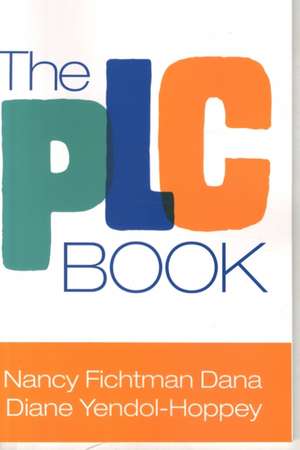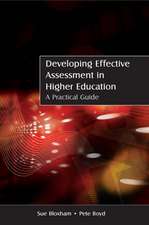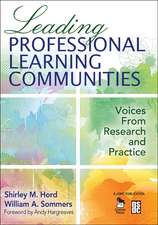The PLC Book
Autor Nancy Fichtman Dana, Diane Yendol-Hoppeyen Limba Engleză Paperback – 4 ian 2016
Preț: 223.80 lei
Nou
Puncte Express: 336
Preț estimativ în valută:
42.84€ • 44.09$ • 36.11£
42.84€ • 44.09$ • 36.11£
Carte disponibilă
Livrare economică 08-22 februarie
Livrare express 25-31 ianuarie pentru 19.95 lei
Preluare comenzi: 021 569.72.76
Specificații
ISBN-13: 9781483382654
ISBN-10: 1483382656
Pagini: 128
Dimensiuni: 178 x 254 x 10 mm
Greutate: 0.23 kg
Ediția:1
Editura: SAGE Publications
Colecția Corwin
Locul publicării:Thousand Oaks, United States
ISBN-10: 1483382656
Pagini: 128
Dimensiuni: 178 x 254 x 10 mm
Greutate: 0.23 kg
Ediția:1
Editura: SAGE Publications
Colecția Corwin
Locul publicării:Thousand Oaks, United States
Recenzii
“The PLC Book is an essential resource for all principals and teachers who wish to create a powerful culture of adult and student learning in their schools. Dana and Yendol-Hoppey created a practical go-to guide designed to help all educators understand and enact an exciting program of professional learning. A must-read for all who are currently engaging in or wish to begin Professional Learning Communities in their schools.”
“The PLC Book is destined to be an essential text in the fields of teacher education, teacher professional development, school administration and a handbook for teachers and others engaged in the pursuit of systemic educational change.”
“The PLC Book is a must-read for anyone wishing to establish a PLC in their school, from the leader looking for a whole-school approach, to the classroom practitioner seeking to connect with a group of educators.”
“The PLC Book is as essential as The Reflective Educator’s Guide to Professional Learning Communities! Their careful guidance and realistic examples support the work of teachers to genuinely learn together based on inquiry, shared common goals and reflective practices.”
“The PLC Book creates a powerful and memorable connection between the idea of Professional Learning Communities and the actuality of creating and sustaining them.”
“The PLC Book will be a go-to resource for teachers, from those looking to begin PLCs for the first time to experienced PLCs looking to refine their collaborative work and get more focused on what makes a difference for student learning.”
“Dana and Yendol-Hoppey have blazed a path of professional development that few have been brave enough to tackle. They understand schools and how they operate on a core level.”
“As no one else, Nancy and Diane master the art of bringing innovative theories into the practice.”
“The PLC Book is destined to be an essential text in the fields of teacher education, teacher professional development, school administration and a handbook for teachers and others engaged in the pursuit of systemic educational change.”
“The PLC Book is a must-read for anyone wishing to establish a PLC in their school, from the leader looking for a whole-school approach, to the classroom practitioner seeking to connect with a group of educators.”
“The PLC Book is as essential as The Reflective Educator’s Guide to Professional Learning Communities! Their careful guidance and realistic examples support the work of teachers to genuinely learn together based on inquiry, shared common goals and reflective practices.”
“The PLC Book creates a powerful and memorable connection between the idea of Professional Learning Communities and the actuality of creating and sustaining them.”
“The PLC Book will be a go-to resource for teachers, from those looking to begin PLCs for the first time to experienced PLCs looking to refine their collaborative work and get more focused on what makes a difference for student learning.”
“Dana and Yendol-Hoppey have blazed a path of professional development that few have been brave enough to tackle. They understand schools and how they operate on a core level.”
“As no one else, Nancy and Diane master the art of bringing innovative theories into the practice.”
Cuprins
Foreword
Acknowledgements
About the Authors
1. PLC Defined
What Is A PLC?
Do PLCs Really Work?
How Do PLCs Work?
Why Is This Book Called The PLC Book?
2. Getting Started
What Getting Started Is and Why It’s Important
How to Get Started
What Does Getting Started Look Like?
Questions For Discussion
3. Establishing A PLC’s Direction
What Establishing A PLC Direction Is and Why It’s Important
How To Establish A Direction For Your PLC
What Does Establishing A Direction For Your PLC Look Like?
Questions For Discussion
4. Developing A PLC Action Learning Plan
What A PLC Action Learning Plan Is and Why It’s Important
How To Develop A PLC Action Learning Plan
What Might Developing An Action Learning Plan Look Like?
Questions For Discussion
5. Analyzing Data In Your PLC
What Data Analysis Is and Why It’s Important
How To Analyze Data
What Might Analyzing Data Look Like?
Questions for Discussion
6. Making PLC Learning Public
What Making PLC Learning Public Is and Why It’s Important
How to Make PLC Learning Public
What Might Sharing the Work of Your PLC Look Like?
Questions for Discussion
7. Essential Elements of Healthy PLCs
Establish a Vision
Build Trust
Understand and Embrace Collaboration
Encourage, Recognize and Appreciate Diversity Within the Group
Promote the Development of Critical Friends
Pay Attention to the Work “In-Between”
Hold the Group Accountable for and Document Their Learning
Have a Comprehensive View of What Constitutes Data
Understand Change and Acknowledge The Discomfort It May Bring
Work With Building Administrators
References
Acknowledgements
About the Authors
1. PLC Defined
What Is A PLC?
Do PLCs Really Work?
How Do PLCs Work?
Why Is This Book Called The PLC Book?
2. Getting Started
What Getting Started Is and Why It’s Important
How to Get Started
What Does Getting Started Look Like?
Questions For Discussion
3. Establishing A PLC’s Direction
What Establishing A PLC Direction Is and Why It’s Important
How To Establish A Direction For Your PLC
What Does Establishing A Direction For Your PLC Look Like?
Questions For Discussion
4. Developing A PLC Action Learning Plan
What A PLC Action Learning Plan Is and Why It’s Important
How To Develop A PLC Action Learning Plan
What Might Developing An Action Learning Plan Look Like?
Questions For Discussion
5. Analyzing Data In Your PLC
What Data Analysis Is and Why It’s Important
How To Analyze Data
What Might Analyzing Data Look Like?
Questions for Discussion
6. Making PLC Learning Public
What Making PLC Learning Public Is and Why It’s Important
How to Make PLC Learning Public
What Might Sharing the Work of Your PLC Look Like?
Questions for Discussion
7. Essential Elements of Healthy PLCs
Establish a Vision
Build Trust
Understand and Embrace Collaboration
Encourage, Recognize and Appreciate Diversity Within the Group
Promote the Development of Critical Friends
Pay Attention to the Work “In-Between”
Hold the Group Accountable for and Document Their Learning
Have a Comprehensive View of What Constitutes Data
Understand Change and Acknowledge The Discomfort It May Bring
Work With Building Administrators
References
Notă biografică
Descriere
The PLC Book is written specifically for teachers, and articulates the essential elements and process of PLC work and how they can collaboratively achieve improved student learning.













